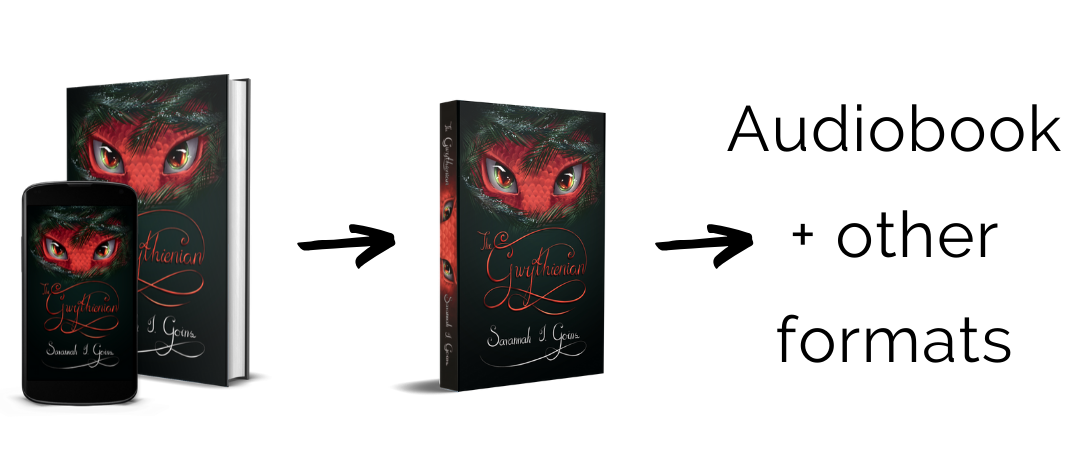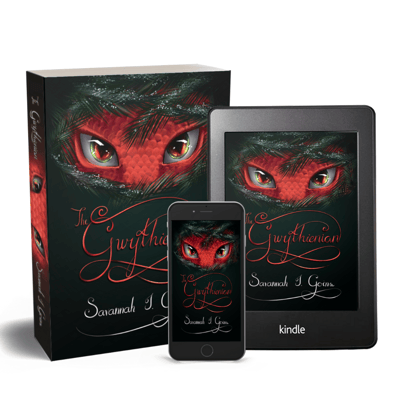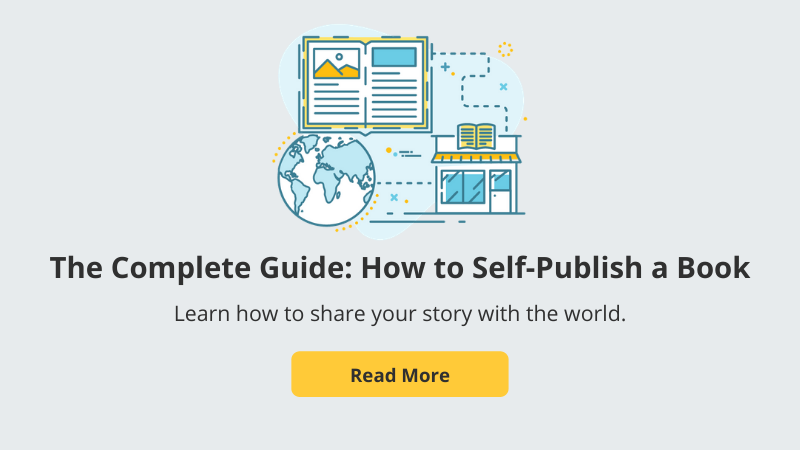Are you considering publishing your book in hardcover? Or converting your existing hardcover to IngramSpark’s new jacketed case laminate option?
Read on!
You’re about to find the answers to all your questions about whether you should have a hardcover at all, how to price a hardcover, how to set it up, and how to upgrade an existing hardcover to the jacketed case laminate. I recently upgraded both of my books to the jacketed case laminate and one hundred percent recommend it. I’ll explain why it’s so awesome in a few minutes. But first, let’s answer the main question: Should you make your book available in hardcover?
Should I Publish a Hardcover?
That’s an excellent question! There are a few things to consider, such as the increased printing cost, whether the readers of your genre expect it to be available in that format, and how you could potentially leverage multiple formats in your production and release timeline.
For starters, examine similar books in the same genre as yours on your bookshelf or on bookstore shelves.
Would you see it in hardcover? Cookbooks, atlases, some nonfiction and most young adult fantasy and dystopian books are usually available in hardcover. This means your target reader has an expectation and you want to be sure to fulfill it.

Unsure whether your genre is commonly available in hardcover?
Try browsing a brick-and-mortar bookstore, googling the question, or asking a friend with similar reading tastes. And even if you find that hardcovers are not common in your genre, consider how much your book might stand out against its peers on the shelves with a sturdier cover. With things like trim sizes, it’s not necessarily good to stand out because being the only book in the genre that’s an inch taller or shorter than all the others isn’t a professional look. But standing out by being higher quality? It might be worth considering.
In fact, even among books that are available in multiple formats, many people prefer the hardcover for its sturdier appearance, durability, and professional appeal.
People are willing to pay more to have the hardcover copy because its perceived value is greater than that of a paperback, even though it has the same information or story inside. A hardcover can help you stand up and stand out among all the other hardcovers, even moreso among paperbacks.
Learn how to design a book in The Ultimate Guide to Master Your Book Cover Design.
And when it comes to book releases, by leveraging different formats you can turn one book release a year into three by first only releasing the hardcover and the ebook, a few months later the paperback, and then follow up with the audiobook. Traditional publishing already tends to publish the hardcover first, so that all the big fans can treat themselves to the fanciest version, and then send the paperback into the world for everyone who wants a less expensive option a few months later.

What if your paperback is already out? Would it still be worth investing in a hardcover?
Yes.
While hardcovers are typically released first, you can certainly still release yours even long after the paperback has been published for a while.
Consider adding some bonus content (such as a chapter from a different character’s perspective, character interviews, a few illustrations, the first chapter of the next book if it’s not out yet, etc.) to stir interest in this new edition.
With the appeal of a hardcover, double the artwork with the jacketed case laminate, and bonus content inside, many people who bought the paperback may still buy the hardcover for all those new exciting features. And they will also go a long way toward attracting new readers.
With my first book, I released hardcover, paperback, and ebook all at the same time because I didn’t know about other options. For my second book, I released the ebook and hardcover initially, and followed up with the release of the paperback about six months later. Having another event to create some buzz about my books boosted my sales and gave me a reason to remind people about them again without being pushy. I intend to stick to this process for future books.
But of course, before making the decision to offer your book in hardcover form, you need to consider the price. Is it worth the increased printing cost? Can you still price your book competitively and make money from it?
How Should I Price My Hardcover?
Check out IngramSpark’s Publisher Comp Calculator to find out. Simply fill in all the info and see what happens. If you don’t know the trim size or page count yet, check Google for common trim sizes for your genre and choose a page count of a similar book on your shelf.
If you have a completed manuscript, estimate the page count by dividing the total word count by 250.
If you haven’t finished your book yet, playing around with these numbers can help you figure out what strategic page number to shoot for to get in the best price range. And for paper type, nonfiction is typically white and fiction is typically crème.
 If your numbers are coming out in the red, something needs to be tweaked. If after tweaking everything you can, you find you are still in the red, a hardcover may not be a good option for your book. This could be the case if your book is significantly larger than most in your genre.
If your numbers are coming out in the red, something needs to be tweaked. If after tweaking everything you can, you find you are still in the red, a hardcover may not be a good option for your book. This could be the case if your book is significantly larger than most in your genre.
For example, if you go with the suggested wholesale discount of 55% off for bookstores, and your young adult fantasy novel is 350 pages at 5.5 X 8.5 trim size, then you’ll have to charge $27.99 for a hardcover just to be in the black. And even at that, your profit is a lovely thirty cents. A typical hardcover in this genre is $15.99-$21.99, so $27.99 is not competitive and if you are a newer author with a budding fanbase, few people will be willing to spend so much extra on your book when they could spend less on a book by someone they are more familiar with.
To find out what range of prices would keep your book competitive, check out similar books on your shelf at home, visit the correct section in a brick-and-mortar bookstore, or look for them on Amazon and be sure that you select the hardcover format before taking note of the price, as the ebook price is usually automatically displayed.
Still too high? Even if the price is working out okay, consider even greater revenues with the scoop on wholesale discounts.
Bookstores typically get a wholesale discount of 55%. That means that your printing costs, shipping costs, and royalties all come out of that remaining 45%. But IngramSpark lets you choose to decrease the wholesale discount to 40%, so that you are working with 60% to cover your costs and pay yourself.
Why doesn’t everyone automatically go with this option?
Because it’s not financially possible for most bookstores to take a risk ordering books by a less well-known author at a significantly low wholesale discount. They might refuse to order your books for book signings. But here’s the thing: Barnes and Noble and Amazon and everyone else, so far as I have seen, will still carry your book on their website even if it’s at the 30% discount. And it’s generally expected for indie authors to bring their own stock into bookstores for book signings anyway.
So change that wholesale discount to 40% and see how your numbers look. The only reason to keep the discount at 55% is to make bookstores more comfortable ordering your books for your signings. So, if you can manage bringing in your own stock or if you didn’t want to do signings in bookstores anyway, take advantage of your control over this.
And just so you know, I had a very successful book launch for my second book at my local Barnes and Noble and they didn’t say a thing about the book being set at the lower wholesale discount rate when they ordered a larger number of books than I expected. And this enabled me to set the $27.99 book in the previous example to $19.99, a much more competitive price, and still make significantly more than thirty cents a copy.
Should I Choose the Jacketed Case Laminate?
If you are leaning toward making a hardcover one of your book’s formats, then let me gush a little about IngramSpark’s jacketed case laminate option.

Previously, the options within IngramSpark were to have a case laminate, which was just a hardcover with the cover design printed straight onto the cover, or to have a jacketed cloth cover, which was a cloth-bound book with the cover art on the removable jacket. The jacket or jacket wrap is a feature with a front flap and a back flap, usually bearing the book blurb and the author bio on these sections, respectively. The case laminate was and still is a fine option, but the jacketed cloth-bound form was what I originally selected for my debut a few years ago because I wanted to look as equal as possible to the traditionally published hardcovers in my book’s section of a bookstore.
The jacketed case laminate is a recently added option within IngramSpark, and it is beyond cool. It allows you to not only have the fancy jacket with flaps, but also print whatever artwork you would like on the cover underneath. So instead of having boring blue cloth under the cover, you can have literally anything you want.
This is not merely just fun in general, but also has the potential to make your book stand out even more and be even better equipped to stand up to comparison with traditionally published books of the same type.
For example, in YA fantasy, it’s common to find the title and a single piece of the cover art—such as a flowering branch, animal silhouette, or blood splatter—hiding behind the beautiful and more intricate jacket wrap. You might also find the cover art done in reverse colors underneath, or the lettering and artwork might be a single complementary metallic color against a black background.
The possibilities are endless. And even though embossing is not yet an option, a talented cover designer could add shadows in just the right places to make it look like lettering and/or other artwork had been stamped in rather than just printed.
Since this underneath cover can be very minimalistic and still achieve great results, it doesn’t have to be expensive to design. You can even commission just a single piece of art as a PNG, and then create the case laminate cover yourself with that art, a free font, and the cover templates I’m about to tell you how to get from IngramSpark. While I do recommend working with a professional, this is also an option.
How Do I Upgrade to the Jacketed Case Laminate?
1. Determine what type of art you want for the jacket and the case laminate.
This could be the same design on both of them, a more traditional style of fancier cover art on the jacket and just the title and a single piece of art underneath, or an artistically embossed-looking version of the cover. I recommend hiring a professional to create this art for you, but there are lots of great resources online for how you can do it yourself. If you are trying to save money or are just intrigued by the challenge of doing this yourself, check out Derek Murphy’s cover creation videos on YouTube after you finish reading this post.
Since this is a relatively new service at the time of writing, you could ask your cover designer to add on this extra, potentially smaller or simplified piece of art at a lesser cost, since you’ve already hired them for everything else and it would be a chance for them to learn about this new service to be better equipped to serve more authors in the future.
2. Provide yourself or your cover artist with the right templates.
Check out IngramSpark’s Cover Template Generator and simply fill in the requested information to get an auto-generated template for both the jacket wrap and the case laminate.
If you are doing it yourself and are not familiar with design software, select the PDF file. If you are accustomed to working with InDesign or similar programs, or if you are working with a cover designer who is, check with them before selecting the file type or send them the link to the template generator and let them fill it out and choose which file is most ideal for their process.
3. Update the cover files in your account.
For setting up a hardcover in the first place, see this article: How to Set Up a Title with IngramSpark after reading this whole post. For instructions on updating to a jacketed case laminate from one of the previous hardcover options, watch the video velow for step by step directions and tips for what to do if you get an error in this phase. But finish reading this article first so you will know what to do next!
4. Order proofs.
Once you’ve either set up your hardcover or updated to the jacketed case laminate, you’ll need to wait a couple of days to receive an eproof from IngramSpark for you to review. Once you’ve approved it (and I one hundred percent recommend combing through it and grabbing a friend or two to get their eyes on it, too) you can accept the update and order physical proof copies.
Holding your book in your hands for the first time is an amazing feeling. For me personally, holding the beautiful hardcover is the best.

A Fantastic Experience That Exceeded Expectations
When I found out about this new option, I was eager to give it a try, but hesitant to pay my cover designer for a whole new design to go underneath. Putting the exact same cover art on the case laminate and the jacket is of course also an option, and one that would be more affordable than having two different covers, but not what I envisioned for this project.
I had recently commissioned a very talented new artist to do artistic renderings of four of my characters, and I pitched the idea to her to give this new kind of art a try. She was in, and a few weeks later her art blew my expectations right out of the water. They went on to be so well received that I’ve made that art that was just meant to be a fun under-the-jacket surprise for the hardcover my permanent paperback and ebook covers as well.
In fact, I’m so in love with this new cover art—which I never would have discovered if not for the jacketed case laminate—that I am considering reversing my jacket wrap with my case binding. So then the new artwork would be on the outside and my original cover art would be underneath, since this new art has been so well-received.
What Should I Do Now?
So, is a hardcover for you? If you can have your book available in this beautiful, professional format and still make money on it, and if you can get the case laminate art for a relatively small additional fee or on your own, why not? If readers of your genre expect a hardcover, you could be losing sales by not having it as a format option. And why not get a little fancy with it so you can stand among other quality books proudly, knowing you produced the very finest cover possible?
Picture this: Your hardcover book, sitting face-out on a Barnes and Noble shelf, surrounded but by no means overshadowed by similar books. The gorgeous jacket art catches the eye of a browser, and they pull it down to take a closer look. They notice the professional jacket wrap with the blurb and bio and flip through the beautifully formatted pages. Just out of curiosity, they peek under the jacket to see if there’s anything there. While the gripping blurb had them considering buying, the surprise pop of even more art hidden within makes the decision for them. What other gems might this book hold?















